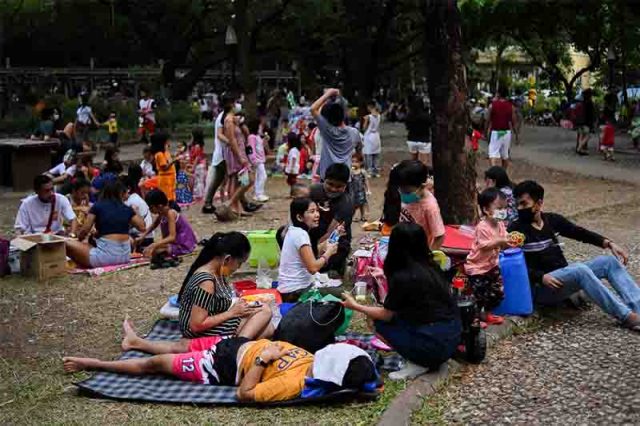
The government was urged to observe the COVID-19 situation in the country first before considering downgrading Metro Manila‘s quarantine status to Alert Level 1 of the general community quarantine.
Health Secretary Francisco Duque in a public briefing said that it is possible the National Capital Region will be placed under the lowest alert level if the national COVID-19 tally goes to 500 or only 1,000 per day.
“Depende iyan. Titingnan natin ang numero, ang datos,” he was quoted as saying on Tuesday.
“Kung ang datos ay patuloy namang bumababa… posible na kapag below 1,000 tayo or 500 [cases] per day, baka puwede nating ibaba pa ng Alert Level 1,” Duque added.
“Sino ba naman ang may ayaw na mas mababa ang ating alert level, e mas malaking bahagi naman ng ekonomiya ang ating mabubuksan at mas marami tayong mababawing trabaho na nawala,” he further said.
However, the health chief also expressed concern about the pictures of huge crowds on social media after NCR has been downgraded to Alert Level 2.
RELATED: Mall-goers told to observe social distancing, wear face masks amid posts on crowding
“Siyempre nakakaalarma ito. Nangangamba ako dahil nga ‘pag iyong nagkukumpol-kumpulan, posibleng makakita na naman tayo ng pagsipa ng mga kaso at dapat po ito maiwasan natin,” Duque said.
He reminded the public to strictly observe the minimum public health protocols and to get vaccinated against COVID-19.
NCR was downgraded to Alert Level 2 last November 5 and this would take effect until November 21.
It was supposed to stay under Alert Level 3 until November 14 but the restrictions were loosened to spur economic recovery as the capital region sees a downward trend of its COVID-19 cases and an increase in vaccination coverage.
Alert Level 1 is implemented when “case transmission is low and decreasing,” and when the total bed utilization rate, as well as the intensitive care unit utilization rate, are “low.”
Under this alert level, intrazonal and interzonal movement are “allowed without regard to age and comorbidities.”
All establishments, persons, or activities are also allowed to operate, work, or be undertaken at full on-site or venue capacity provided it is consistent with the minimum public health standards.
Face-to-face classes in basic education, however, are subject to further approval by the president.
Meanwhile, Duque’s comments were not received well by some concerned Filipinos who urged the national government to review NCR’s COVID-19 situation before making such quarantine measure changes.
“How about observing and studying the effects of Alert Level 2 first? It was just a few days ago when it was lowered to AL (Alert Level) 2, AL 1 agad?” a Twitter user commented in response to the reports.
“Then they will blame the people when surges happen. Not that anyone wants to have a surge, but the way people are out and about with their unvaccinated children is a scary scenario,” she added.
“Kalma lang po muna tayo, we just shifted to Alert Level 2 a few days ago. As we see more and more people going outside, it would be best if we observe the situation first and evaluate prior to giving our people FALSE HOPE and FALSE SENSE OF SAFETY/SECURITY!” a Twitter user from the medical community wrote.
“Hoy Ginoong Duque. Masyado ka namang natutuwa. Medyo alarming nga ‘yung pangdami ng mga bata sa mall,” another online user commented.
As of Tuesday, there are 30,544 active COVID-19 cases in the country. It is the lowest since February 28, according to ABS-CBN data analytics head Edson Guido.
It is also the country’s lowest daily tally since February 17, although 14 laboratories were not able to submit data, he said.
Guido also reported that it is the country’s intensive care unit bed occupancy remains at the safe zone at 42%.
OCTA Research fellow Guido David tweeted that if the COVID-19 trend continues, NCR may only see “less than 200” new cases per day by the end of November.
Last weekend, Duque’s agency had a different projection.
The Department of Health said that active COVID-19 cases could shoot up to more than 50,000 by mid-December if the public will disregard health protocols. This comes with increased mobility from 82% to 91%, based on their projections.
“An uptrend of active cases was observed in scenarios where there is increased mobility from 82% to 91% and a corresponding decrease in the compliance to MPHS (minimum public health standards) by 26%,” the DOH was quoted in a statement on Saturday.
“In these scenarios, active cases may reach up to 25,305 to 29,811 by the end of November and 33,891 to 52,393 by mid-December,” the health agency added.
FASSSTER is the Feasibility Analysis of Syndromic Surveillance Using Spatio-Temporal Epidemiological Modeler For Early Detection of Diseases, a disease surveillance tool used by the DOH.
When NCR shifted to Alert Level 2 before, concerned citizens called on the public to refrain from abusing the “opportunities” they have in the particular quarantine status.









